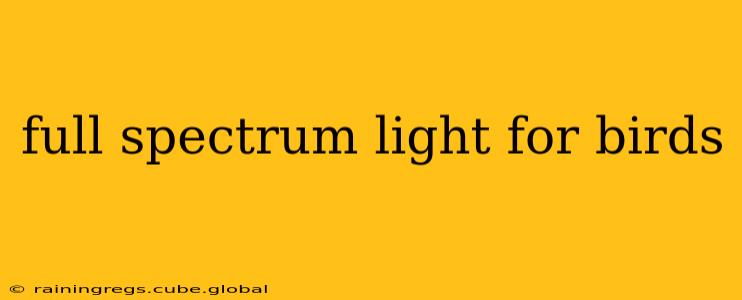Full spectrum lighting is becoming increasingly popular among bird keepers, promising a healthier and happier environment for their feathered friends. But what exactly is full spectrum light, and does it truly benefit birds? This comprehensive guide delves into the science behind full spectrum lighting and explores its impact on avian health and well-being. We'll also address common concerns and questions to help you make an informed decision for your flock.
What is Full Spectrum Lighting?
Full spectrum lighting aims to mimic natural sunlight, encompassing the entire range of visible light wavelengths, as well as ultraviolet (UV) light, which is invisible to the human eye but crucial for many animals, including birds. Unlike standard incandescent or fluorescent bulbs, full spectrum lights are designed to emit a wider and more balanced spectrum of light, closer to the natural light birds experience outdoors. This is achieved through different technologies, including LED and fluorescent bulbs specifically formulated for this purpose.
Why is Full Spectrum Light Important for Birds?
The benefits of full spectrum lighting extend beyond simple illumination. These benefits are linked to several key aspects of avian health:
-
Vitamin D3 Production: UVB light is essential for birds to synthesize vitamin D3, a crucial nutrient for calcium absorption and strong bones. A deficiency can lead to metabolic bone disease (MBD), a serious and often fatal condition. Full spectrum lighting helps birds produce the necessary Vitamin D3, mitigating this risk.
-
Improved Feather Quality: Adequate UV light is also important for maintaining healthy feather growth and coloration. Birds exposed to full spectrum lighting often exhibit brighter, more vibrant plumage.
-
Enhanced Behavior and Activity: The more natural light cycle provided by full spectrum bulbs can lead to more natural activity patterns, reducing stress and promoting healthy behaviors such as preening and foraging. This closer-to-nature environment contributes positively to a bird's overall well-being.
-
Boosting Immunity: Studies suggest that full spectrum lighting can help strengthen a bird's immune system, making them less susceptible to illness.
What are the Different Types of Full Spectrum Lights for Birds?
Several types of full spectrum lights are available for avian use:
-
LED Full Spectrum Bulbs: These are increasingly popular due to their energy efficiency, longevity, and lower heat output compared to other options. However, it's vital to choose bulbs specifically designed for birds, ensuring appropriate UV output.
-
Fluorescent Full Spectrum Bulbs: Fluorescent bulbs have been used for quite some time in avian care and are a reliable option. Again, verify that the bulb is specifically formulated for avian use and has the appropriate UVB spectrum.
How Many Hours of Full Spectrum Light Should My Birds Get?
The ideal amount of light exposure varies depending on the bird species. It's essential to research the specific lighting needs of your birds. Generally, a 12-14 hour light cycle is common for many bird species, mimicking natural daylight hours. Always provide a period of darkness for rest and sleep.
Are There Any Downsides to Using Full Spectrum Lighting for Birds?
While generally beneficial, there are a few considerations:
-
UVB Intensity: Excessive UVB exposure can be harmful. Choose bulbs with appropriate UVB output and carefully follow the manufacturer's instructions.
-
Heat Production: Some full spectrum bulbs can generate significant heat, especially incandescent ones. Ensure adequate ventilation to prevent overheating, especially in smaller cages.
-
Cost: Full spectrum bulbs can sometimes be more expensive than standard bulbs, but their benefits outweigh the cost in terms of avian health.
Can I use a Full Spectrum Light for All Types of Birds?
No, not all birds benefit equally from full spectrum lighting. Some species have different lighting requirements. Always research your bird species' specific needs to ensure you select and use full spectrum lighting correctly.
How Often Should I Replace My Full Spectrum Light Bulb?
Full spectrum bulbs, like all bulbs, degrade over time, reducing their effectiveness. Most manufacturers recommend replacement every 6-12 months. Regularly inspect the bulbs and replace them when their UV output noticeably diminishes.
Conclusion:
Full spectrum lighting offers significant advantages for maintaining the health and happiness of companion birds. By providing a light source that more closely mimics natural sunlight, it helps birds produce vital vitamin D3, maintain healthy feather quality, and enjoy more natural behavioral patterns. Choosing the right bulb, understanding UVB intensity, and following proper usage guidelines are key to ensuring the full benefits of full spectrum lighting for your avian companions. Remember always to consult with an avian veterinarian for specific advice tailored to your bird's species and individual needs.
